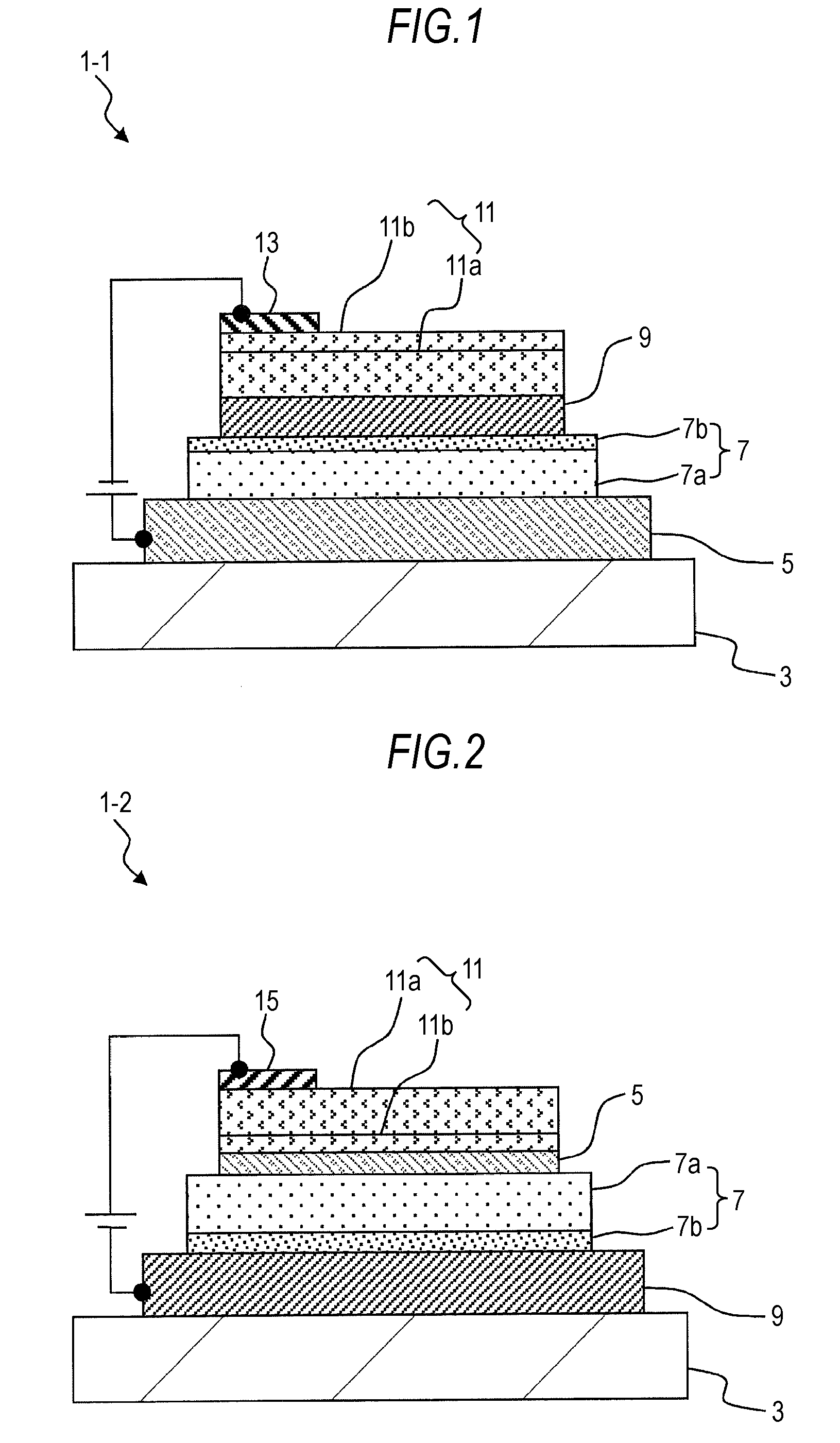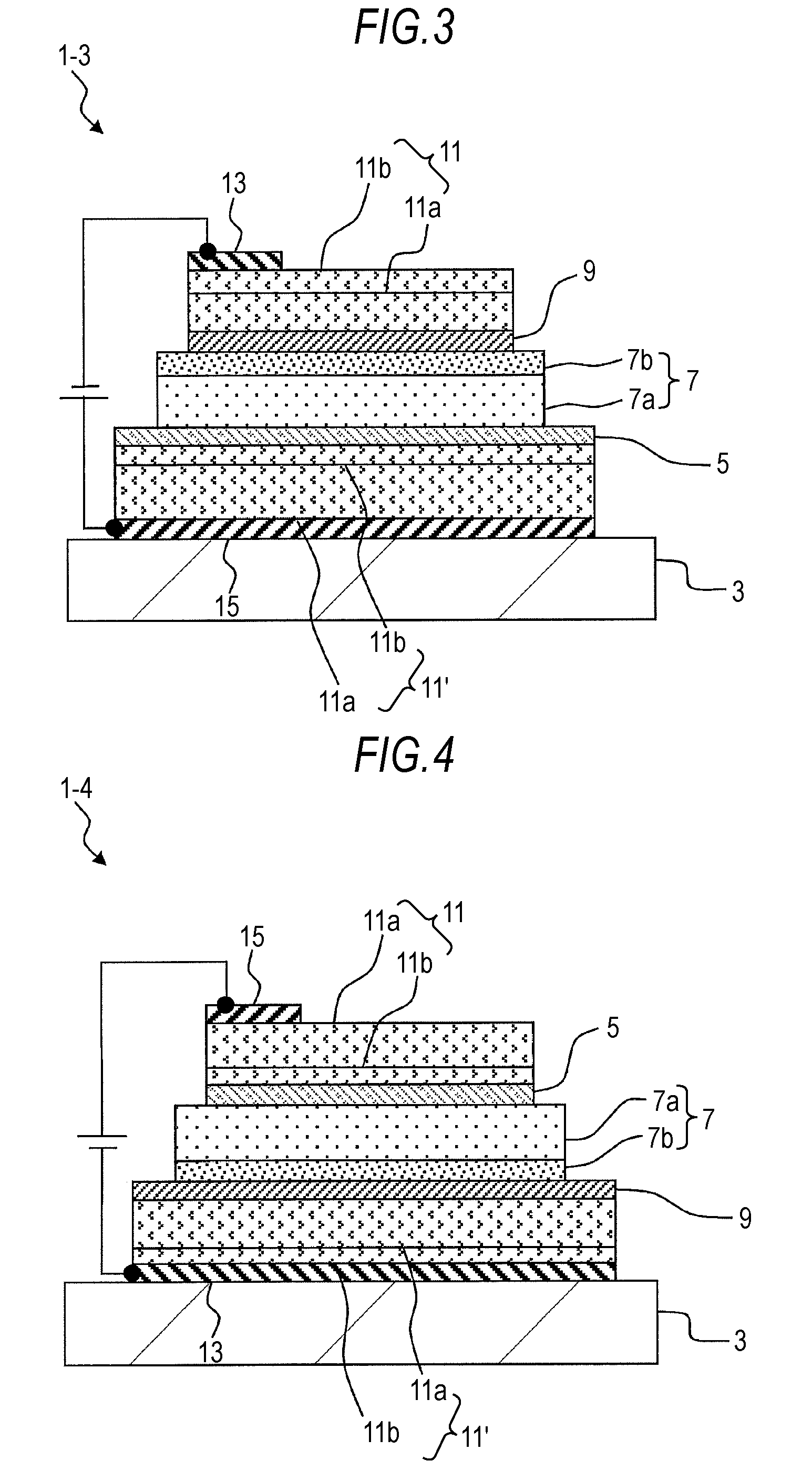Organic electroluminescent device and display device
a technology of electroluminescent devices and organic electroluminescent devices, which is applied in the direction of discharge tubes/lamp details, discharge tubes luminescnet screens, natural mineral layered products, etc., can solve the problems of slow deposition rate of conductive organic film of pedot on the electrode, damage of organic layer such as an organic emissive layer by solvent damage, etc., to improve the emission efficiency of organic electroluminescent devices, improve productivity, and accelerate vapor deposition ra
- Summary
- Abstract
- Description
- Claims
- Application Information
AI Technical Summary
Benefits of technology
Problems solved by technology
Method used
Image
Examples
first embodiment
[0036]FIG. 1 is a cross sectional view schematically illustrating an organic electroluminescent device 1-1 of an embodiment of the present invention. The organic electroluminescent device 1-1 is a first example suited for top emission, and includes an anode 5 provided as a lower electrode on a substrate 3, an organic emission functional layer 7 overlaid on the anode 5, and a cathode 9 provided as an upper electrode on the organic emission functional layer 7. Further, an organic electrode film 11 and a cathode wire 13 are provided on the cathode 9. A characteristic of an embodiment of the present invention is that the organic electrode film 11 is formed using the materials described below.
[0037]The following description will be given through the case where the organic electroluminescent device 1-1 of the stacked configuration is a top-emitting device in which the light is drawn from the side of the cathode 9 opposite from the substrate 3. Details of each layer in this configuration w...
second embodiment
[0088]FIG. 2 is a cross sectional view schematically illustrating an organic electroluminescent device 1-2 according to another embodiment of the present invention. The organic electroluminescent device 1-2 is a second example suited for top emission, and differs from the First Embodiment in the order of stacking; namely, it has a reverse stacked configuration in which the cathode 9 and the anode 5 are used as the lower and upper electrodes, respectively. Note that each layer of the organic electroluminescent device 1-2 will be described with reference to the same reference numerals used in the First Embodiment, and no detailed descriptions will be given concerning the materials of these layers because the same materials are used as in the First Embodiment.
[0089]Specifically, the organic electroluminescent device 1-2 includes a cathode 9 provided as a lower electrode on a substrate 3, an organic emission functional layer 7 overlaid on the cathode 9, and an anode 5 provided as an upp...
third embodiment
[0098]FIG. 3 is a cross sectional view schematically illustrating an organic electroluminescent device 1-3 according to another embodiment of the present invention. The organic electroluminescent device 1-3 is a first example suited for top-and-bottom emission, and additionally includes an organic electrode film 11′ on the lower electrode anode 5 side in the configuration of the First Embodiment. Note that each layer of the organic electroluminescent device 1-3 will be described with reference to the same reference numerals used in the First Embodiment, and no detailed descriptions will be given concerning the materials of these layers because the same materials are used as in the First Embodiment.
[0099]Specifically, the organic electroluminescent device 1-3 has a stacked configuration in which an anode wire 15 and the organic electrode film 11′ are formed on the substrate 3 in this order, and in which the anode 5, the organic emission functional layer 7, the cathode 9, the organic ...
PUM
| Property | Measurement | Unit |
|---|---|---|
| thickness | aaaaa | aaaaa |
| deposition rate | aaaaa | aaaaa |
| thickness | aaaaa | aaaaa |
Abstract
Description
Claims
Application Information
 Login to View More
Login to View More - R&D
- Intellectual Property
- Life Sciences
- Materials
- Tech Scout
- Unparalleled Data Quality
- Higher Quality Content
- 60% Fewer Hallucinations
Browse by: Latest US Patents, China's latest patents, Technical Efficacy Thesaurus, Application Domain, Technology Topic, Popular Technical Reports.
© 2025 PatSnap. All rights reserved.Legal|Privacy policy|Modern Slavery Act Transparency Statement|Sitemap|About US| Contact US: help@patsnap.com



